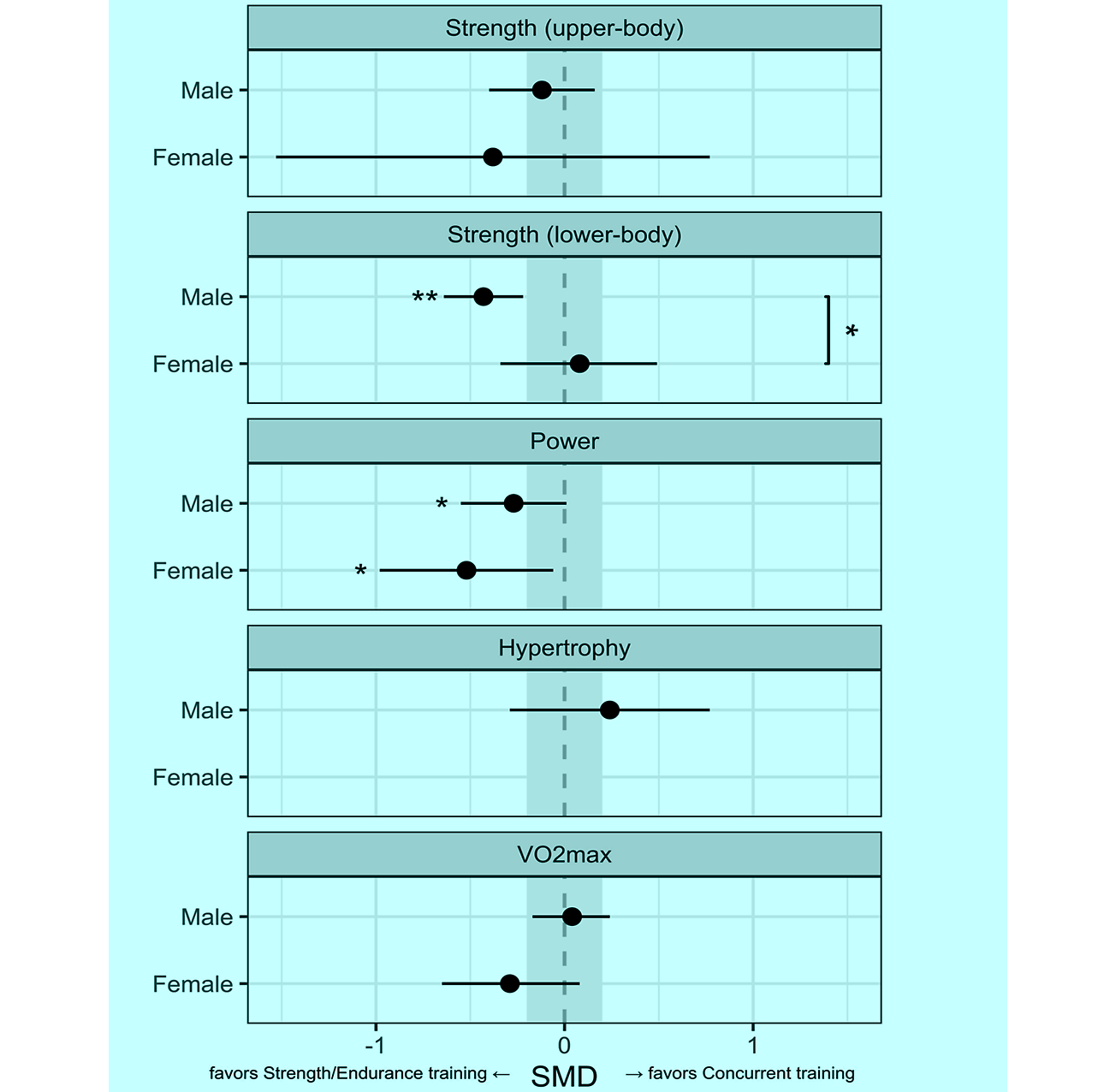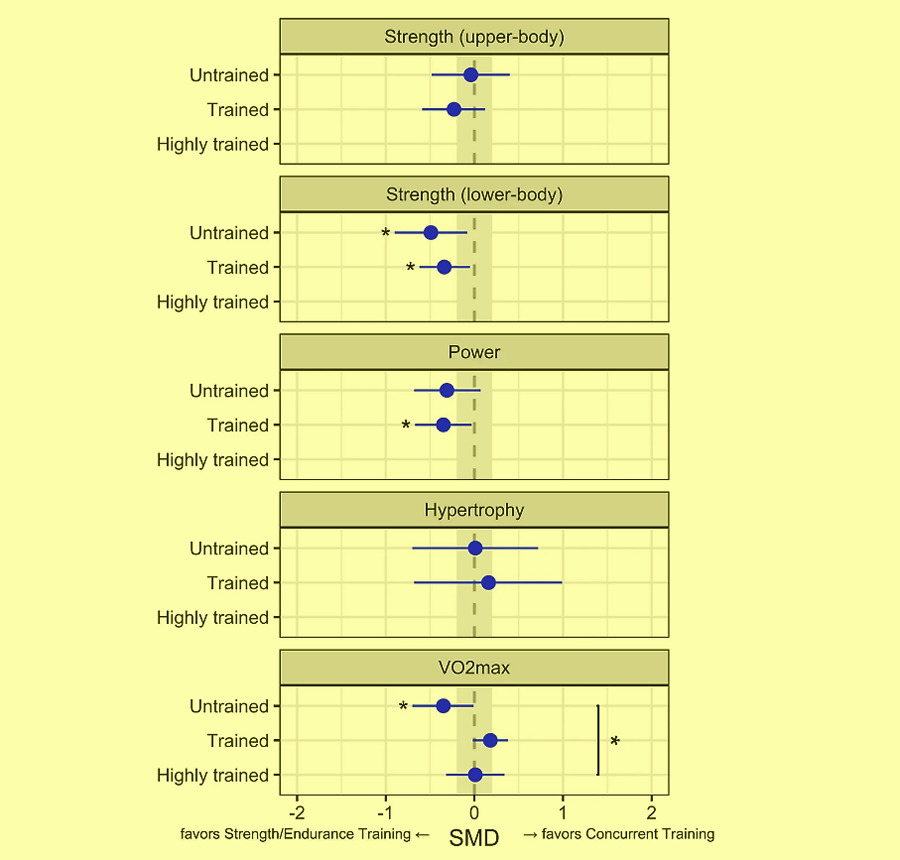You are viewing 1 of your 1 free articles. For unlimited access take a risk-free trial
Endurance and strength: have the best of both worlds!
How does training for strength affect endurance and vice-versa? And how do biological sex and training history affect the gains you make? SPB looks at new research and makes practical recommendations
There are very few sports that rely exclusively on either high levels of strength or high levels of endurance performance. While weightlifting and ultramarathon running are good examples of sports that do, most sports require a combination of both good levels of strength and endurance, albeit in varying proportions(1,2). For this reason, most athletes (who really want to maximize performance) need to perform concurrent training in their overall program. This means they need to practice both endurance and strength training within the same time period – the ratios of which will be determined by their sport.
Concurrent training conundrum
Although it sounds straightforward, there are problems with concurrent endurance and strength training. Firstly, when muscles are trained by strength or endurance exercise, the outcomes are very different, providing either size and strength/power gains or oxygen delivery and utilization gains respectively. In other words, strength training produces little or no gains in oxygen delivery and utilization while endurance training does not improve strength/power.
However, the situation is actually even more problematical; studies show that the extremes of these two traits are physiologically incompatible because there is an inverse relationship between muscle fiber cross-sectional area and mitochondrial oxidative capacity(3-5). In plain English, training mainly for strength appears to limit the capacity for endurance gains, while training mainly for endurance seems to blunt the capacity for strength gains.
Having said this, the real-world situation for athletes in training is rather more nuanced. It is known for sure that concurrent training potentially leads to blunted strength, power, or muscle growth adaptations compared with strength training alone. This was actually established back in 1980 by a sports scientists called Robert Hickson in his landmark study titles ‘Interference of strength development by simultaneously training for strength and endurance’(6).
In the interim period however, our understanding of the endurance-strength interference effect has grown considerably. In a meta-analysis study last year on this subject (a study that pools all the data from previous studies to form more robust conclusions), researchers found that compared to strength-only training, adding endurance training impaired power gains but did not adversely impact maximal strength or muscle growth(7). Moreover, a 2021 study on how strength training impacts endurance found that maximal oxygen uptake (a key parameter of aerobic power) was not adversely impacted by adding in strength training to an endurance program(8).
Different athletes respond differently
One reason put forward by scientists for the conflicting findings on concurrent training is that different individuals may respond differently to a concurrent training program (and the fact that different studies have used a variety of training interventions). Of particular relevance to the training response seems to be the sex and the training status of the athlete.
It is well established that males have more skeletal muscle mass, and greater strength than females, and tend to see greater improvements in absolute muscle size, strength, and power compared with females for the same training load and training duration(9-11). Conversely, females undergoing strength training tend to experience larger relative increases in upper-body strength than males(12). Given these facts, it might not be surprising if female athletes were to respond differently to males when performing concurrent training.
Training status could also affect the interference effect that is commonly observed in concurrent training. In a 2017 study, researchers put forward reasons why training adaptations could be more negatively impacted following concurrent training in athletes with a longer training history and who are more highly trained(13). This ties in with anecdotal reports from athletes whose sports require both high levels of sprinting/peak power and high levels of endurance (for example, rowers and cyclists), and who seem to find that optimizing both endurance and peak power at the same time is more difficult and less successful than focussing on just one or the other(14). Confusingly however, previous analyses on concurrent training have not found any significant effect of training status when it comes to developing for maximal strength, power, and hypertrophy(15).
New research
To try and tease out the truth about what athletes can really expect in terms of endurance strength gains when undertaking concurrent training, we can turn to new research from a team of Dutch scientists from the University of Amsterdam(16). Published in the journal ‘Sports Medicine’, this study investigated how the sex of an athlete affects adaptations in strength, power, muscle hypertrophy, and maximal oxygen consumption when performing concurrent strength and endurance training. It also investigated how these concurrent training adaptations are influenced by an athlete’s strength and endurance training status (ie whether they are highly trained, moderately trained or relatively untrained).
The research was carried out by means of a meta-analysis – ie pooling and analyzing the data from all previous studies on concurrent training. When the scientific literature was scoured, there were 59 previous studies that were analyzed. All these studies had to meet the following strict criteria:
· Healthy male and female adults aged between 18 and 50 years.
· A study consisting of concurrent strength and endurance training for at least 4 weeks.
· Endurance training included cycling, cross-country skiing, swimming, rowing or running.
· Strength training involved improving strength, power, and/or muscle growth, and included concentric, eccentric or plyometrics training.
· The concurrent training groups were compared to either an endurance training-only group (where maximum oxygen uptakes were compared, or a strength training-only group (where maximal lower-body and upper-body strength, power or muscle growth were compared).
· When muscle growth/size was measured, this had to be via whole-muscle cross-sectional area using ultrasound, magnetic resonance imaging, or computed tomography (ie accurate!).
· No studies were included if participants experienced injuries or an illness, or if they used ergogenic aids or other sport-enhancing supplements (except for proteins and vitamins).
As well as investigating whether biological sex affected the concurrent training outcomes, the researchers also looked at training status. Strength training status was classified according to established criteria as untrained, trained (ie intermediately trained athletes), and highly trained(17). Likewise, endurance training status was classified as untrained, trained (ie recreationally trained individuals), and highly trained athletes (ie well-trained and professional athletes)(18).
What they found
The first finding to emerge was that while there were a lot of studies on concurrent training, the number of studies on trained and highly trained athletes performing concurrent training was relatively small. Nevertheless, there was enough data to reveal two key findings:
1. Compared to strength-only training, concurrent training (ie adding in endurance work) resulted in blunted lower-body strength adaptations in males. However, this effect was NOT observed in females (see figure 1).
2. When it came to training status, untrained individuals displayed impaired improvements for maximal oxygen consumption with concurrent training. In other words, compared to endurance-only training, adding in strength work as part of a concurrent program resulted in less endurance gains(see figure 2). However, this result was NOT seen in trained and highly trained athletes.
Figure 1: Strength-only vs. concurrent training outcomes in males and females

Effect of training status on endurance gains
Related Files

Practical implications for athletes
Let’s try and summarize the data and tease out the practical implications for athletes. Firstly, the data from this study (see figure 1) and from other studies mentioned above clearly shows that when maximum power development is the goal, performing endurance training in addition to strength training blunts the power gains that can be had from strength training alone. For athletes where power and acceleration is key therefore (eg high and long jumpers, 100m sprinters etc) , endurance training as part of a concurrent program is not recommended – at least when approaching the main competitive season.
The same is true to a lesser extent for lower body strength development; adding in endurance to a strength program seems to blunt strength gains compared to strength-only training. Interestingly however, this is only true for male athletes, who need to bear this in mind when preparing for an event where maximal lower-body strength is required (eg track/sprint cyclists). Female athletes on the other hand do not seem to suffer this effect when they train concurrently, so they can simultaneously endurance train with fear of blunted lower body strength gains.
The really good news for trained endurance athletes here is that adding in strength training to an endurance program does not appear to blunt endurance gains in any way compared to an endurance-only program. This is particularly encouraging as the addition of regular strength training can bring gains in power, reduced injury risk and improved ‘muscle economy’, which means the muscles become more efficient, requiring less oxygen to maintain a sub-maximal pace. However, for novice endurance athletes who are just finding their way into endurance sport and trying to develop a fitness base (ie relatively untrained), the recommendation is different. In this case, adding strength training to an endurance-only program does seem to impair the endurance gains that would otherwise be expected. Therefore, it may be better to build up a decent aerobic fitness base by endurance-only training for a few months before considering adding in some strength work!
References
1. Physiol Rev. 2022;103:2057–70
2. Med Sci Sports Exerc. 2006;38:1965–70
3. FASEB J. 2018;32:2110–23
4. Eur J Appl Physiol. 2010;110:665–94
5. Front Sports Act Living. 2021;3: 719434
6. Eur J Appl Physiol Occup Physiol. 1980;45:255–63
7. Sports Med. 2022;52:601–12
8. Int J Sports Med. 2021;43:297–304
9. J Appl Physiol. 2000;89:81–8
10. Med Sci Sports Exerc. 1988;20:338–44
11. J Gerontol A Biol Sci Med Sci. 1999;54:M591–6
12. J Strength Cond Res. 2020;34:1448–60
13. J Physiol. 2017;595:2883–96
14. J Sports Sci. 2018;36:2111–20
15. J Strength Cond Res. 2012;26:2293–307
16. Sports Med. 2023 Oct 17. doi: 10.1007/s40279-023-01943-9. Online ahead of print
17. Strength Cond J. 2021;43:77–86
18. Int J Sports Physiol Perform. 2013;8:111–22
Newsletter Sign Up
Testimonials
Dr. Alexandra Fandetti-Robin, Back & Body Chiropractic
Elspeth Cowell MSCh DpodM SRCh HCPC reg
William Hunter, Nuffield Health
Newsletter Sign Up
Coaches Testimonials
Dr. Alexandra Fandetti-Robin, Back & Body Chiropractic
Elspeth Cowell MSCh DpodM SRCh HCPC reg
William Hunter, Nuffield Health
Keep up with latest sports science research and apply it to maximize performance
Today you have the chance to join a group of athletes, and sports coaches/trainers who all have something special in common...
They use the latest research to improve performance for themselves and their clients - both athletes and sports teams - with help from global specialists in the fields of sports science, sports medicine and sports psychology.
They do this by reading Sports Performance Bulletin, an easy-to-digest but serious-minded journal dedicated to high performance sports. SPB offers a wealth of information and insight into the latest research, in an easily-accessible and understood format, along with a wealth of practical recommendations.
*includes 3 coaching manuals
Get Inspired
All the latest techniques and approaches
Sports Performance Bulletin helps dedicated endurance athletes improve their performance. Sense-checking the latest sports science research, and sourcing evidence and case studies to support findings, Sports Performance Bulletin turns proven insights into easily digestible practical advice. Supporting athletes, coaches and professionals who wish to ensure their guidance and programmes are kept right up to date and based on credible science.










